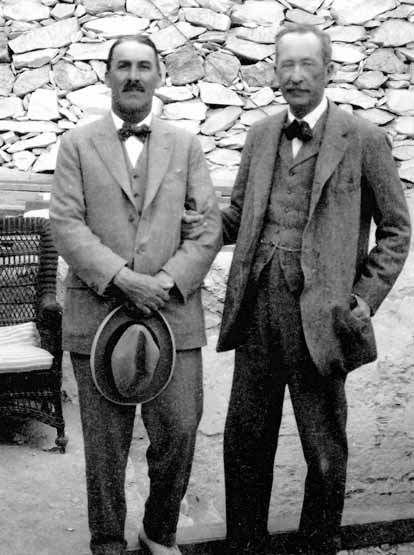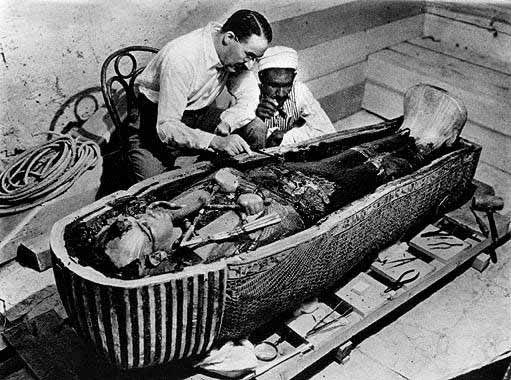Death Shall
Come on Swift Wings To Him Who Disturbs the Peace of
the King... -Supposedly engraved on the exterior
of King Tutankhamen's Tomb
The king
was only nineteen when he died, perhaps murdered by
his enemies. His tomb, in comparison with his contemporaries,
was modest. After his death, his successors made an attempt
to expunge his memory by removing his name from all the
official records. Even those carved in stone. As it
turns out, his enemy's efforts only ensured his
eventual fame. His name was Tutankhamen: King Tut.
The ancient Egyptians revered their Pharaohs as
Gods. Upon their deaths the King's bodies were carefully
preserved by embalming. The mummified corpses were
interned in elaborate tombs (like the Great Pyramid) and
surrounded with all the riches the royals would need in
the next life. The tombs were then carefully sealed.
Egypt's best architects designed the structures to
resist thieves. In some cases heavy, hard-granite
plugs were used to block passageways. In others,
false doorways and hidden rooms were designed to fool
intruders. Finally, in a few cases, a curse was placed
on the entrance.
Most of these precautions
failed. In ancient times grave robbers found their
way into the tombs. They unsealed the doors, chiseled
their way around the plugs and found the secrets of
the hidden rooms. They stripped the dead Kings of
their valuables. We will never know if any of the thieves suffered
the wrath of a curse.
Archaeologists
from Europe became very interested in Egypt in the
19th century. They uncovered the old tombs and
explored their deep recesses always hoping to find that one
forgotten crypt that had not been plundered in antiquity. They
knew that the Pharaohs had been buried with untold
treasures that would be of immense artistic,
scientific, and monetary value. Always the
archaeologists were disappointed.
The Search for the
Missing King
In 1891 a young Englishman
named Howard Carter arrived in Egypt. Over the years
he became convinced that there was at least one
undiscovered tomb. That of the almost unknown King
Tutankhamen. Carter found a backer for his tomb search
in the wealthy Lord Carnarvon. For five years Carter dug looking
for the missing Pharaoh and found nothing.

Carter and Carnarvon
Carnarvon summonded Carter to England
in1922 to tell him he was was calling off the search.
Carter managed to talk the lord into supporting him
for one more season of digging. Returning to Egypt
the archaeologist brought with him a yellow canary.
A Few Authentic Curses from
Mummy Tombs
As for any man who shall destroy these, it is the god Thoth who shall destroy him. As for him who shall destroy this inscription: He shall not reach his home. He shall not embrace his children. He shall not see success. |
"A
golden bird!" Carter's foreman, Reis Ahmed,
exclaimed. "It will lead us to the tomb!"
Perhaps it did. On November 4th, 1922 Carter's
workmen discovered a step cut into the rock that had been hidden
by debris left over from the building of the tomb of
Ramesses IV.. Digging further they found fifteen more
leading to an ancient doorway that appeared to be
still sealed. On the doorway was the name
Tutankhamen.
When Carter arrived home that
night his servant met him at the door. In his hand he
clutched a few yellow feathers. His eyes large with
fear, he reported that the canary had been killed by a
cobra. Carter, a practical man, told the servant to
make sure the snake was out of the house. The man grabbed
Carter by the sleeve.
"The pharaoh's
serpent ate the bird because it led us to the hidden
tomb! You must not disturb the tomb!"
Scoffing
at such superstitious nonsense, Carter sent the man
home.
Carter immediately sent a telegram to
Carnarvon in England and waited anxiously for his
arrival. Carnarvon made it to Egypt by November 26th
and watched as Carter made a hole in the door. Carter
leaned in, holding a candle, to take a look. Behind
him Lord Carnarvon asked, "Can you see anything?"
Carter
answered, "Yes, wonderful things."
The
day the tomb was opened was one of joy and
celebration for all those involved. Nobody seemed to be concerned
about any curse. Rumors later circulated that Carter had
found a tablet with the curse inscribed on it, but
hid it immediately so it would not alarm his workers.
Carter denied doing so.

The
tomb was intact and contained an amazing collection
of treasures including a stone sarcophagus. The sarcophagus
contained three gold coffins nested within each other. Inside
the final one was the mummy of the boy-king, Pharaoh
Tutankhamen.
The
Curse Strikes?
A
few months after the tomb's opening tragedy struck.
Lord Carnarvon, 57, was taken ill and rushed to Cairo.
He died a few days later. The exact cause of death was not known,
but it seemed to be from an infection started by an
insect bite. Legend has it that when he died there
was a short power failure and all the lights
throughout Cairo went out. His son reported that back
on his estate in England his favorite dog howled and
suddenly dropped dead.
Even more strange,
when the mummy of Tutankhamun was unwrapped in 1925,
it was found to have a wound on the left cheek in the
same exact position as the insect bite on Carnarvon
that lead to his death.
By 1929 eleven people
connected with the discovery of the Tomb had died
early and of unnatural causes. This included two of
Carnarvon's relatives, Carter's personal secretary, Richard
Bethell, and Bethell's father, Lord Westbury. Westbury killed
himself by jumping from a building. He left a note that
read, "I really cannot stand any more horrors and
hardly see what good I am going to do here, so I am
making my exit."

What
horrors did Westbury refer to?
The
press followed the deaths carefully attributing each
new one to the "Mummy's Curse" By 1935 they had credited
21 victims to King Tut. Was there really a curse? Or was it
all just the ravings of a sensational press?
Herbert E. Winlock, the director of the Metropolitan
Museum of Art in New York City, made his own calculations about
the effectiveness of the curse. According to to
Winlock's figures of the 22 people present when the
tomb was opened in 1922, only 6 had died by 1934. Of
the 22 people present at the opening of the
sarcophagus in 1924, only 2 died in the following ten
years. Also ten people were there when the mummy was unwrapped
in 1925, and all survived until at least 1934.
In 2002 a medicine scholar at Monash University
in Melbourne, Australia, named Mark Nelson, completed a study
which purportedly showed that the curse of King Tut never
really existed. Nelson selected 44 Westerners in
Egypt at the time the tomb was discovered. Of those,
twenty-five of the group were people potentially
exposed to the curse either because they were at the
breaking of the sacred seals in the tomb, or at the
opening of the sarcophagus, or at the opening of the
coffins, or the unwrapping of the mummy. The study showed that
these exposures had no effect on the length of their survival
when compared to those not exposed.
Perhaps,
the power of a curse is in the mind of the person
who believes in it. Howard Carter, the man who actually
opened the tomb, never believed in the curse and lived to a
reasonably old age of 66 before dying of entirely natural
causes.
A
Rational Explaination?
Several people have
suggested that illnesses associated with the ancient
Egyptian tombs may have a rational explanation based
in biology. Dr. Ezzeddin Taha, of Cairo University, examined
the health records of museum workers and noticed that many of
them had been exposed to Aspergillus niger, a
fungus that causes fever, fatigue and rashes. He
suggested that the fungus might have been able to
survive in the tombs for thousands of years and then
was picked up by archaeologists when they entered.
Dr. Nicola Di Paolo, a Italian physician identified
another possible fungus, Aspergillus ochraceus,
at Egyptian archaeological sites suggesting it might
also have made visitors to the tomb, or even those
that just handled artifacts from the tombs, sick. Aspergillus
ochraceus has not been shown to be fatal,
however.
In 1999 a German
microbiologist, Gotthard Kramer, from the University
of Leipzig, analyzed 40 mummies and identified
several potentially dangerous mold spores on each. Mold spores
are tough and can survive thousands of years even in a dark,
dry tomb. Although most are harmless, a few can be
toxic.
Kramer thinks that when tombs were first
opened and fresh air gusted inside, these spores
could have been blown up into the air. "When spores
enter the body through the nose, mouth or eye mucous
membranes, " he adds, "they can lead to organ failure
or even death, particularly in individuals with
weakened immune systems."
For this reason
archaeologists now wear protective gear (such as
masks and gloves) when unwrapping a mummy, something
explorers from the days of Howard Carter and Lord Carnarvon
didn't do.
So was the curse of the mummy a
mold spore named Aspergillus flavus or Cephalosporium?
Or was it all media hype? Or is there another
explaination?
from UnMuseum.org


0 comments:
Post a Comment